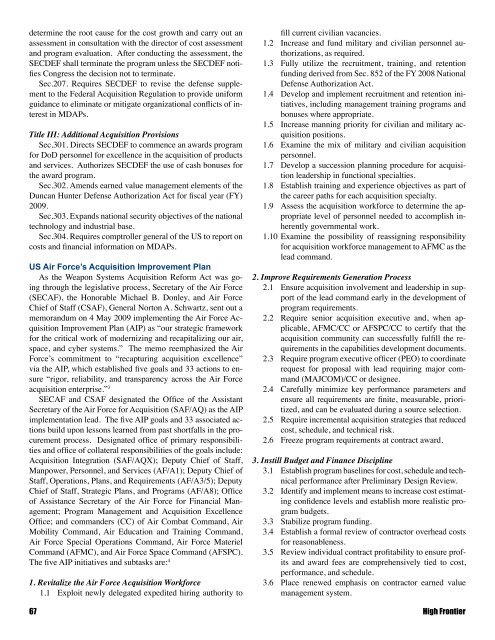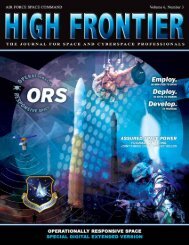Space Acquisition - Air Force Space Command
Space Acquisition - Air Force Space Command
Space Acquisition - Air Force Space Command
You also want an ePaper? Increase the reach of your titles
YUMPU automatically turns print PDFs into web optimized ePapers that Google loves.
determine the root cause for the cost growth and carry out an<br />
assessment in consultation with the director of cost assessment<br />
and program evaluation. After conducting the assessment, the<br />
SECDEF shall terminate the program unless the SECDEF notifies<br />
Congress the decision not to terminate.<br />
Sec.207. Requires SECDEF to revise the defense supplement<br />
to the Federal <strong>Acquisition</strong> Regulation to provide uniform<br />
guidance to eliminate or mitigate organizational conflicts of interest<br />
in MDAPs.<br />
Title III: Additional <strong>Acquisition</strong> Provisions<br />
Sec.301. Directs SECDEF to commence an awards program<br />
for DoD personnel for excellence in the acquisition of products<br />
and services. Authorizes SECDEF the use of cash bonuses for<br />
the award program.<br />
Sec.302. Amends earned value management elements of the<br />
Duncan Hunter Defense Authorization Act for fiscal year (FY)<br />
2009.<br />
Sec.303. Expands national security objectives of the national<br />
technology and industrial base.<br />
Sec.304. Requires comptroller general of the US to report on<br />
costs and financial information on MDAPs.<br />
US <strong>Air</strong> <strong>Force</strong>’s <strong>Acquisition</strong> Improvement Plan<br />
As the Weapon Systems <strong>Acquisition</strong> Reform Act was going<br />
through the legislative process, Secretary of the <strong>Air</strong> <strong>Force</strong><br />
(SECAF), the Honorable Michael B. Donley, and <strong>Air</strong> <strong>Force</strong><br />
Chief of Staff (CSAF), General Norton A. Schwartz, sent out a<br />
memorandum on 4 May 2009 implementing the <strong>Air</strong> <strong>Force</strong> <strong>Acquisition</strong><br />
Improvement Plan (AIP) as “our strategic framework<br />
for the critical work of modernizing and recapitalizing our air,<br />
space, and cyber systems.” The memo reemphasized the <strong>Air</strong><br />
<strong>Force</strong>’s commitment to “recapturing acquisition excellence”<br />
via the AIP, which established five goals and 33 actions to ensure<br />
“rigor, reliability, and transparency across the <strong>Air</strong> <strong>Force</strong><br />
acquisition enterprise.” 3<br />
SECAF and CSAF designated the Office of the Assistant<br />
Secretary of the <strong>Air</strong> <strong>Force</strong> for <strong>Acquisition</strong> (SAF/AQ) as the AIP<br />
implementation lead. The five AIP goals and 33 associated actions<br />
build upon lessons learned from past shortfalls in the procurement<br />
process. Designated office of primary responsibilities<br />
and office of collateral responsibilities of the goals include:<br />
<strong>Acquisition</strong> Integration (SAF/AQX); Deputy Chief of Staff,<br />
Manpower, Personnel, and Services (AF/A1); Deputy Chief of<br />
Staff, Operations, Plans, and Requirements (AF/A3/5); Deputy<br />
Chief of Staff, Strategic Plans, and Programs (AF/A8); Office<br />
of Assistance Secretary of the <strong>Air</strong> <strong>Force</strong> for Financial Management;<br />
Program Management and <strong>Acquisition</strong> Excellence<br />
Office; and commanders (CC) of <strong>Air</strong> Combat <strong>Command</strong>, <strong>Air</strong><br />
Mobility <strong>Command</strong>, <strong>Air</strong> Education and Training <strong>Command</strong>,<br />
<strong>Air</strong> <strong>Force</strong> Special Operations <strong>Command</strong>, <strong>Air</strong> <strong>Force</strong> Materiel<br />
<strong>Command</strong> (AFMC), and <strong>Air</strong> <strong>Force</strong> <strong>Space</strong> <strong>Command</strong> (AFSPC).<br />
The five AIP initiatives and subtasks are: 4<br />
1. Revitalize the <strong>Air</strong> <strong>Force</strong> <strong>Acquisition</strong> Workforce<br />
1.1 Exploit newly delegated expedited hiring authority to<br />
fill current civilian vacancies.<br />
1.2 Increase and fund military and civilian personnel authorizations,<br />
as required.<br />
1.3 Fully utilize the recruitment, training, and retention<br />
funding derived from Sec. 852 of the FY 2008 National<br />
Defense Authorization Act.<br />
1.4 Develop and implement recruitment and retention initiatives,<br />
including management training programs and<br />
bonuses where appropriate.<br />
1.5 Increase manning priority for civilian and military acquisition<br />
positions.<br />
1.6 Examine the mix of military and civilian acquisition<br />
personnel.<br />
1.7 Develop a succession planning procedure for acquisition<br />
leadership in functional specialties.<br />
1.8 Establish training and experience objectives as part of<br />
the career paths for each acquisition specialty.<br />
1.9 Assess the acquisition workforce to determine the appropriate<br />
level of personnel needed to accomplish inherently<br />
governmental work.<br />
1.10 Examine the possibility of reassigning responsibility<br />
for acquisition workforce management to AFMC as the<br />
lead command.<br />
2. Improve Requirements Generation Process<br />
2.1 Ensure acquisition involvement and leadership in support<br />
of the lead command early in the development of<br />
program requirements.<br />
2.2 Require senior acquisition executive and, when applicable,<br />
AFMC/CC or AFSPC/CC to certify that the<br />
acquisition community can successfully fulfill the requirements<br />
in the capabilities development documents.<br />
2.3 Require program executive officer (PEO) to coordinate<br />
request for proposal with lead requiring major command<br />
(MAJCOM)/CC or designee.<br />
2.4 Carefully minimize key performance parameters and<br />
ensure all requirements are finite, measurable, prioritized,<br />
and can be evaluated during a source selection.<br />
2.5 Require incremental acquisition strategies that reduced<br />
cost, schedule, and technical risk.<br />
2.6 Freeze program requirements at contract award.<br />
3. Instill Budget and Finance Discipline<br />
3.1 Establish program baselines for cost, schedule and technical<br />
performance after Preliminary Design Review.<br />
3.2 Identify and implement means to increase cost estimating<br />
confidence levels and establish more realistic program<br />
budgets.<br />
3.3 Stabilize program funding.<br />
3.4 Establish a formal review of contractor overhead costs<br />
for reasonableness.<br />
3.5 Review individual contract profitability to ensure profits<br />
and award fees are comprehensively tied to cost,<br />
performance, and schedule.<br />
3.6 Place renewed emphasis on contractor earned value<br />
management system.<br />
67 High Frontier











